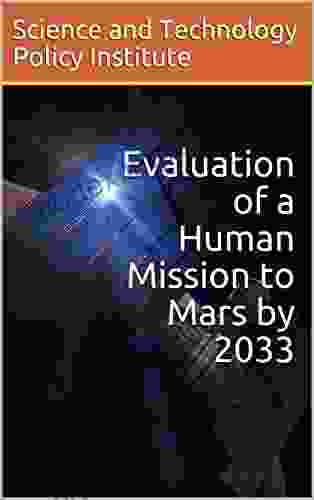Evaluation Of Human Mission To Mars By 2033


The allure of Mars, our neighboring planet, has captivated the imaginations of scientists, explorers, and dreamers for centuries. With its enigmatic red surface, potential for harboring life, and the challenges it presents, Mars has become a focal point of space exploration.
In recent years, the prospect of human missions to Mars has gained significant momentum. Governments, space agencies, and private companies are actively working towards making this ambitious goal a reality. This article will delve into the complexities of human missions to Mars, evaluating their feasibility, exploring the technological challenges, and examining the potential benefits and risks associated with such an endeavor.
4.6 out of 5
| Language | : | English |
| File size | : | 8201 KB |
| Text-to-Speech | : | Enabled |
| Screen Reader | : | Supported |
| Enhanced typesetting | : | Enabled |
| Word Wise | : | Enabled |
| Print length | : | 233 pages |
Technological Challenges
Undertaking a human mission to Mars poses numerous technological challenges that must be overcome. One of the most significant hurdles is the vast distance between Earth and Mars, which can range from 55 to 401 million kilometers depending on their relative positions in their orbits.
This distance translates to a travel time of several months, requiring a spacecraft capable of sustaining a crew for an extended period. The spacecraft must be equipped with life support systems, radiation shielding, and propulsion systems that can withstand the rigors of space travel.
Another challenge lies in landing on Mars' surface. The planet's thin atmosphere and rugged terrain make it difficult for spacecraft to enter and land safely. Engineers are developing innovative landing systems, such as inflatable heat shields and precision-guided rockets, to address this issue.
Scientific Objectives
Beyond the technological challenges, human missions to Mars offer tantalizing scientific opportunities. Mars is a planet with a rich and complex geological history, and its study can provide valuable insights into the evolution of rocky planets, the search for life beyond Earth, and the potential for human habitation in space.
Crewed missions can conduct in-depth geological surveys, collect samples for analysis, and perform experiments that are not possible with robotic probes. They can also explore regions that are inaccessible to rovers or landers, providing a more comprehensive understanding of Mars' surface and subsurface.
Potential Benefits
The potential benefits of a human mission to Mars extend far beyond scientific knowledge. Such a mission would inspire generations, foster international cooperation, and drive technological advancements that have the potential to benefit humanity in numerous ways.
The challenges of sending humans to Mars will require innovation and ingenuity, leading to advancements in fields such as materials science, propulsion systems, and life support technologies. These innovations can have applications in various industries, such as medicine, transportation, and energy.
Furthermore, a human presence on Mars could open up new possibilities for economic development and scientific research, potentially leading to the establishment of a permanent human settlement on the Red Planet.
Risks and Challenges
While the prospect of human missions to Mars is exciting, it is crucial to acknowledge the risks and challenges involved. The journey to Mars is long and perilous, and the Martian environment poses significant hazards to human health and safety.
Radiation exposure, extreme temperatures, and the psychological effects of prolonged isolation can all take a toll on astronauts. Maintaining a healthy and functioning crew over the course of a multi-year mission will require careful planning and mitigation strategies.
Additionally, the high cost of human missions to Mars, coupled with the uncertainties of space exploration, raises questions about the allocation of resources and the prioritization of such endeavors.
International Cooperation
Given the immense challenges and costs involved, international cooperation is essential for the success of human missions to Mars. No single country or space agency has the resources and expertise to undertake such a complex project alone.
International collaborations can pool resources, share knowledge, and reduce the overall costs. The International Space Station (ISS) serves as a model for successful international cooperation in space exploration, and it has paved the way for future joint missions to Mars.
Timeline and Feasibility
The timeline for a human mission to Mars is subject to ongoing debate and depends on the availability of funding, technological advancements, and political will. Some experts believe that the first crewed mission to Mars could occur as early as the 2030s, while others estimate a more conservative timeline of the 2040s or later.
The feasibility of human missions to Mars hinges on overcoming the technological challenges, securing adequate funding, and maintaining international cooperation. While there are still uncertainties and risks to consider, the progress made in space exploration over the past decades suggests that a human mission to Mars is a realistic and achievable goal.
Human missions to Mars represent a bold and ambitious endeavor that has the potential to revolutionize our understanding of the universe and our place within it. While significant technological challenges remain, the potential scientific discoveries, economic benefits, and inspirational impact of such missions make them a worthwhile pursuit.
Through international cooperation, innovation, and unwavering determination, humanity can overcome the obstacles and make the dream of a human presence on Mars a reality. The journey to Mars will be fraught with challenges, but it is a journey that will undoubtedly shape our future and inspire generations to come.
4.6 out of 5
| Language | : | English |
| File size | : | 8201 KB |
| Text-to-Speech | : | Enabled |
| Screen Reader | : | Supported |
| Enhanced typesetting | : | Enabled |
| Word Wise | : | Enabled |
| Print length | : | 233 pages |
Do you want to contribute by writing guest posts on this blog?
Please contact us and send us a resume of previous articles that you have written.
 Book
Book Novel
Novel Page
Page Chapter
Chapter Text
Text Story
Story Genre
Genre Reader
Reader Library
Library Paperback
Paperback E-book
E-book Magazine
Magazine Newspaper
Newspaper Paragraph
Paragraph Sentence
Sentence Bookmark
Bookmark Shelf
Shelf Glossary
Glossary Bibliography
Bibliography Foreword
Foreword Preface
Preface Synopsis
Synopsis Annotation
Annotation Footnote
Footnote Manuscript
Manuscript Scroll
Scroll Codex
Codex Tome
Tome Bestseller
Bestseller Classics
Classics Library card
Library card Narrative
Narrative Biography
Biography Autobiography
Autobiography Memoir
Memoir Reference
Reference Encyclopedia
Encyclopedia Che Boielle
Che Boielle Bob Rich
Bob Rich C Douglas Kroll
C Douglas Kroll C J Duvall Jr
C J Duvall Jr Robert N Trigiano
Robert N Trigiano Brian Fleig
Brian Fleig Norberto R Keppe
Norberto R Keppe Brynna Cadman
Brynna Cadman Bob Hunter
Bob Hunter Jane Nelsen
Jane Nelsen Hillel Levine
Hillel Levine Richard Delacy
Richard Delacy Brad Bertelli
Brad Bertelli Boye Lafayette De Mente
Boye Lafayette De Mente Marian Pallister
Marian Pallister Bret Christian
Bret Christian Bruce D Heald
Bruce D Heald Brandon J Weichert
Brandon J Weichert Bruce W Longenecker
Bruce W Longenecker Jake Hinkson
Jake Hinkson
Light bulbAdvertise smarter! Our strategic ad space ensures maximum exposure. Reserve your spot today!
 Sean TurnerFollow ·15.8k
Sean TurnerFollow ·15.8k Langston HughesFollow ·16.5k
Langston HughesFollow ·16.5k Edwin CoxFollow ·13.6k
Edwin CoxFollow ·13.6k Angelo WardFollow ·19.3k
Angelo WardFollow ·19.3k Walter SimmonsFollow ·11.6k
Walter SimmonsFollow ·11.6k Blake BellFollow ·3.9k
Blake BellFollow ·3.9k Jason HayesFollow ·12.4k
Jason HayesFollow ·12.4k Ira CoxFollow ·15k
Ira CoxFollow ·15k

 Gary Cox
Gary CoxUnlocking Meaning and Purpose in Life: An Exploration of...
In an increasingly...

 Eric Hayes
Eric HayesMemoirs of the Early Pioneer Settlers of Ohio Illustrated
A Window into the Lives of Courageous...

 J.R.R. Tolkien
J.R.R. TolkienThe Montgomerys and Their Descendants: A Saga of Courage,...
Prepare to be...

 Avery Simmons
Avery SimmonsThe Rifle Musket: The Dawn of Modern Infantry Warfare
: The rifle musket, a revolutionary...

 Jesse Bell
Jesse BellUnlock the Power of Excel with VBA and Macros: A...
Microsoft Excel is a powerful spreadsheet...
4.6 out of 5
| Language | : | English |
| File size | : | 8201 KB |
| Text-to-Speech | : | Enabled |
| Screen Reader | : | Supported |
| Enhanced typesetting | : | Enabled |
| Word Wise | : | Enabled |
| Print length | : | 233 pages |














